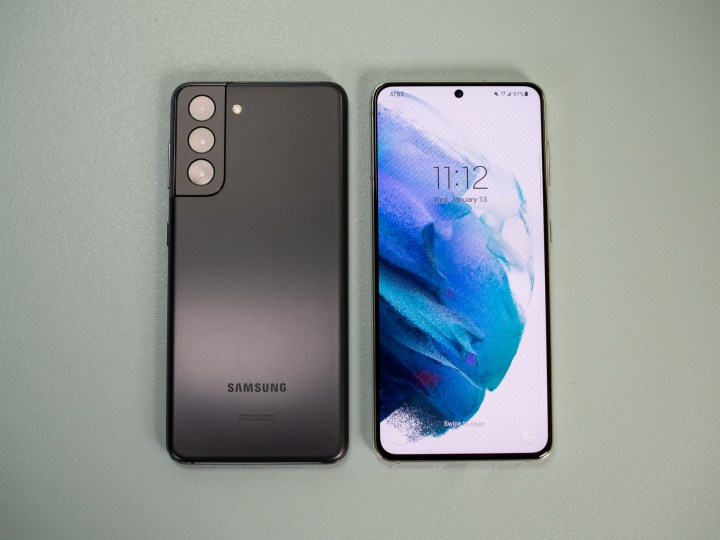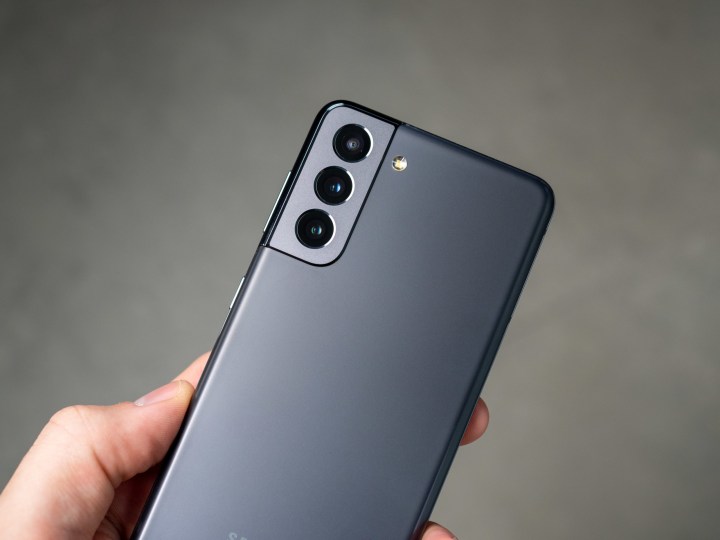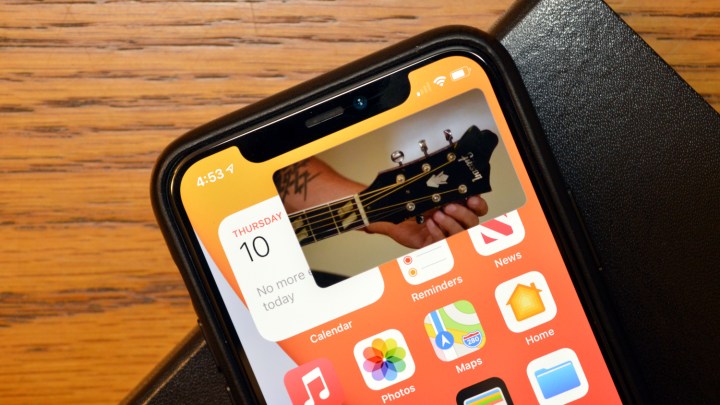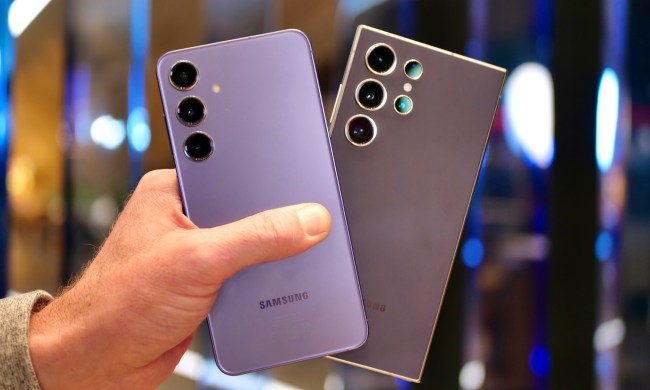Samsung has released the Samsung Galaxy S21, the successor to last year’s Galaxy S20. It improves on its predecessor in several key areas, introducing improved software, a refreshed design, 5G as standard, and the latest Qualcomm Snapdragon 888 processor. It certainly looks like the kind of smartphone you’d expect to encounter in 2021, but it still has competition as the latest and greatest flagship to buy.
Chief among its competitors is the iPhone 12, Apple’s latest showcase for its smartphone tech and wizardry. Like the S21, the iPhone 12 improves on the Apple phones that came before it, providing 5G as standard, a new high-powered processor, and an enhanced camera system. However, we need to find out which one is best for you. To do this, we compare the two phones across several categories, which together should help you decide which is worthier of your money.
Specs
| iPhone 12 | Samsung Galaxy S21 | |
| Size | 146.7 x 71.5 x 7.4mm (5.78 x 2.81 x 0.29 inches) | 151.7 x 71.2 x 7.9 mm (5.97 x 2.80 x 0.31 inches) |
| Weight | 164 grams (5.78 ounces) | 171 grams (6.02 ounces) |
| Screen size | 6.1-inch Super Retina XDR OLED | 6.2-inch Dynamic AMOLED 2X |
| Screen resolution | 2532 x 1170 pixels (460 pixels per inch) | 2400 x 1080 pixels (421 ppi density) |
| Operating system | iOS 14 | Android 11 |
| Storage | 64GB, 128GB, 256GB | 128GB, 256GB |
| MicroSD card slot | No | No |
| Tap-to-pay services | Apple Pay | Samsung Pay |
| Processor | Apple A14 Bionic | Qualcomm Snapdragon 888 (Exynos 2100 outside of U.S. and China) |
| RAM | 4GB | 8GB |
| Camera | Dual lens 12-megapixel wide and 12MP ultrawide rear, 12MP TrueDepth front | Triple lens 12MP wide, 12MP ultrawide and 64MP telephoto rear, 10MP dual-pixel front |
| Video | 4K at up to 60 fps, 1080p at 240 fps | 8K up to 30 fps, 4K at up to 60 fps, 1080p at 120 fps |
| Bluetooth version | Bluetooth 5.0 | Bluetooth 5.0 |
| Ports | Lightning connector | USB C, Type 3.2 |
| Fingerprint sensor | No, FaceID instead | Yes, in-display |
| Water resistance | IP68 | IP68 |
| Battery | 2,815mAh
Fast charging (20W charger sold separately) Qi wireless charging |
4,000mAh
Fast charging (25W charger sold separately) Qi wireless charging |
| App marketplace | Apple App Store | Google Play Store |
| Network support | All major carriers | All major carriers |
| Colors | Black, blue, green, white, and red | Phantom Gray, Phantom White, Phantom Violet, Phantom Pink |
| Prices | $799+ | $799+ |
| Review score | 4.5 out of 5 stars | 3.5 out of 5 stars |
Design, display, and durability

The Samsung Galaxy S21 and iPhone 12 both feature designs that offer subtle evolutions over their predecessors, without rocking the boat too much. The iPhone 12 comes with an angular, flat-sided body, comprising an aluminum frame and a glass back with a nice matte finish. It also has a smaller notch than before, although you’ll be hard-pressed to notice a significant difference, which makes the S21’s pinhole selfie camera seem all the more impressive.
The S21 looks much like the S20, although the bezels around its edge-to-edge screen are thinner. This makes it look sharper and sleeker, and with the nice camera module that slopes around the adjacent edge of the phone, it arguably looks more attractive than its Apple counterpart. However, it is made of plastic, which is a big drawback on an $800 phone.
The S20 has also taken a step backward with its 6.2-inch display. It packs 2400 x 1080 pixels, fewer than not only the S20, but also the iPhone 12’s 2532 x 1170. This will result in a slight drop in picture crispness, although the use of dynamic AMOLED technology, as well as support for a 120Hz refresh rate, will largely compensate for any difference.
Both smartphones come with an IP68 rating, letting you submerge them in up to 1.5 meters of water for a full half an hour. Apple also suggests its Ceramic Guard glass will provide greater protection against falls and damage, although Samsung is making use of the new Victus range of Gorilla Glass, so it too will offer more durability than previous iterations.
This is a close round, but the plastic back on the S21 tips it in the iPhone’s favor.
Winner: iPhone 12
Performance, battery life, and charging

The iPhone 12 is powered by the new A14 Bionic chip, which Apple ridiculously claims does things that “defy the laws of physics.” Hyperbole aside, it’s still one of the best chips on any phone today, and when you combine it with 4GB of RAM, it will handle pretty much every task you need it to handle.
By contrast, the Samsung Galaxy S21 boasts 8GB of RAM, making it seem more impressive paper. It also houses a new Qualcomm Snapdragon 888, unless you live outside of the U.S., China, or Japan, in which case you get the slightly less agile Exynos 2100. Either way, you might suppose that the S21 eclipses the iPhone 12 with its 8GB of RAM. However, this won’t be the case in practice, since given that A14 chip and the different way iPhone’s utilize RAM, both devices should perform similarly.
The iPhone 12 only provides 64GB of internal memory as standard, while the S21 will give you double as standard. Both phones have a 256GB version for more money, while the iPhone 12 also offers a 128GB model. This gives Samsung’s phone a distinct advantage, although the opportunity to take an even bigger lead is squandered as the S21 doesn’t contain the usual MicroSD card slot, so there’s no ability to upgrade your storage even further.
As for batteries, the iPhone 12 delivers a 2,815mAh cell. Again, this doesn’t sound like much on paper, but the fine balance of Apple’s software and the efficiency of the A14 chip means that it comfortably lasts into a second day under moderate-to-heavy use. The S21 comes with a larger, 4,000mAh battery, but our review found that it actually struggles to make it through a full day if you use it heavily. It’s certainly not an unreliable battery, but it is a little underwhelming, so this round goes to the iPhone 12.
Winner: iPhone 12
Cameras

The iPhone 12’s rear camera setup consists of a 12-megapixel wide and ultrawide lens, while the S21 does one better, adding a 64MP telephoto lens into the mix. As before, this superficially implies that the S21 will have a distinct advantage, though in practice you’re likely to see the iPhone 12 perform just as well, if not better.
Our review found that the iPhone 12 takes excellent shots during the day, as well as highly usable shots in low-light and night conditions. It’s a remarkably versatile camera, with its use of Smart HDR 3 and the A.I.-based Deep Fusion technology ensuring your photographs are balanced and colorful, without being too bright or saturated.
With the S21, you’ll get almost exactly the same camera experience as the S20. Its hardware is largely the same as its predecessor, with the same three rear lenses, as well as much of the same core technology. However, the S21 has some software upgrades, including improved A.I. and the introduction of Single Take 2.0. That said, the overall performance is pretty much identical, with the cameras taking very nice shots in most conditions, but struggling a tad in low-light and when trying to take pictures of people indoors.
In light of these failings, we’re giving this round to Apple’s phone.
Winner: iPhone 12
Software and updates

Each operating system has its strengths and weaknesses, and needless to say, both the iPhone 12 and Samsung Galaxy S21 come with the latest versions of each running on them. However, the S21 comes with OneUI 3, Samsung’s skin for Android 11.
On the other hand, there’s little doubt that Apple is much better at rolling out timely software updates than Samsung. Given that it develops iOS, users of the iPhone 12 will receive new versions and updates very quickly. By contrast, Samsung has something of an unenviable track record in terms of delivering new versions of Android, so users may find that they have to wait a while before they can update. They may also find that Samsung doesn’t support the S21 as long as Apple will support the iPhone 12.
This round is another win for the iPhone 12, simply because of its slight superiority when it comes to updates.
Winner: iPhone 12
Special features

Both the Samsung Galaxy S21 and the iPhone 12 support 5G. This is great for anyone living near a 5G network, although unfortunately for non-American iPhone 12 owners, the faster mmWave 5G band will be available only on models sold in the U.S. The S21 supports both main 5G bands in almost all the territories it’s sold.
Aside from 5G, the iPhone 12 also benefits from MagSafe charging (and accessories), letting you attach wireless chargers and various other add-ons simply by bringing it close to the back of your phone. It’s obviously not a ground-breaking innovation, but it should improve convenience (and safety) once enough third-party manufacturers release a critical mass of compatible accessories.
The S21 also introduces a couple of new special features. Most notably, it brings “Vlogger View” to its camera, allowing users to capture video with its front and rear cameras simultaneously. It also adds Director View, which provides picture-in-picture thumbnails of the feed from the S21’s different camera lens, so that you can artfully transition from one to the other while shooting video. These aren’t massive inclusions, but they are nice to see.
As mentioned above, the S21 also supports a liquid-smooth 120Hz refresh rate, while the iPhone 12 offers the ever-dependable Face ID. That said, both phones also have a rather “un-special” feature: Neither ships with a charger (you’ll have to supply your own). These both have a range of features, so this round is a tie.
Winner: Tie
Price and availability
The iPhone 12 starts from $799 for the 64GB version, while the 128GB and 256GB versions will cost you $849 and $949, respectively. It’s available from every major carrier and the vast majority of major retail outlets, in addition to Apple.
The Samsung Galaxy S21 also begins from $799 for the 128GB model, and the 256GB version will set you back $849. As with the iPhone 12, it’s supported by all major carriers and pretty much every big retailer, while you can also buy it direct from Samsung’s website.
Overall winner: iPhone 12

The Samsung Galaxy S21 is newer, but the iPhone 12 is the better phone overall. Its main advantages are its camera, battery, software, and, in particular, its updates, which will be delivered to users more speedily than the S21’s. It will also most likely be supported for longer, meaning that you can buy it now and not worry about upgrading to a new model for three or four years, or perhaps longer.
Other than that, both smartphones are fairly well-matched. The S21 arguably looks better, while the iPhone 12 offers a higher resolution display. They both provide similar levels of performance, with the A14 Bionic chip compensating for the iPhone 12’s lower RAM count.
Of course, if you prefer Android to iOS, you may naturally prefer the Galaxy S21 over the iPhone 12, and vice versa. Either way, you’re unlikely to be disappointed with either phone, so in the end, you probably shouldn’t stress too much and simply go with whichever one you fancy the most.



